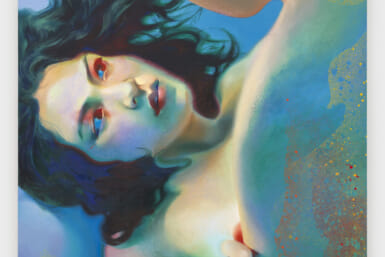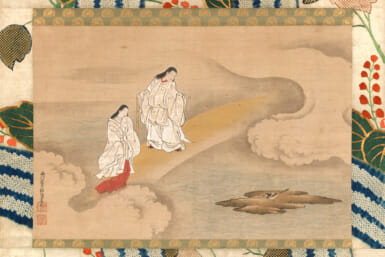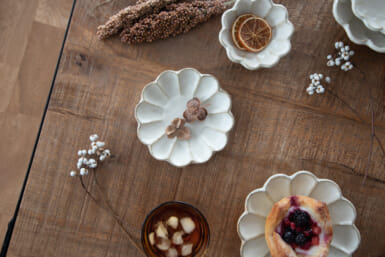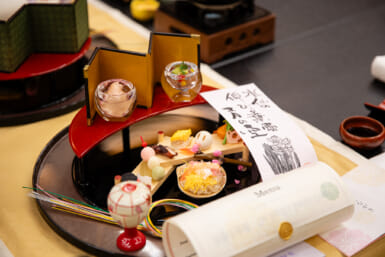by Yurie Horiguchi
Since this is the season for starting the first cold of the year, due to the hiatus between turning off the air-conditioner and waiting for the building superintendent to turn on the heating, let me give you some age-old and time-tested Japanese cold remedies.
The first requisite to curing a cold is to take a hot, hot bath, preferably in a Japanese tub. After emerging, boiled to the proper consistency, wrap yourself in a dotera, or padded kimono, and go straight to bed, turning your electric-blanket on to “high.”
In the meantime your wife/husband, mother, daughter or maid should have prepared a steaming glass of shoga-yu, made by pouring hot water over grated ginger (shoga).
If you don’t care much for ginger, try oroshi-yu, made with grated daikon (Japanese radish—the long, white thing you grate for adding to tempura sauce).
Either drink, taken in bed, is guaranteed to make you sweat out your cold.
Or you might like to try grilled mandarin oranges. Place them on a rack over the gas burner, and grill until the outer skin is burned black. Then you cat the whole thing, skin and all. It will have a bitter taste, but everyone knows that bitter medicines are the most effective at least, that’s what my mother used to say.
Tamago-sake, or hot sake with egg, is the Japanese equivalent of the egg-nog, but as the Japanese don’t celebrate Christmas the way Christian foreigners do, they recommend it for a cold cure instead.
The formula is to put a pint (2 cups) of sake into a pan and heat until steaming, but not boiling. Then beat in an egg yolk.
To my mind, the most interesting way of curing the common cold, however, is to order a hot soba or udon (noodles) dish from a nearby sobaya and have your wife/husband, mother, daughter or maid bring it to you as you simmer in the hot tub.
If the bowl is placed on a small wooden tray, it will float in the tub and you can enjoy it as you soak.
This was a special service provided by many public bath-houses before and up to about the middle of the Meiji era (the turn of the century), and is a custom whose disappearance is regretted by the many who have read about it.
The late Mock Joya, in his delightfully informative book on “Things Japanese” has a whole list of home cures. He is careful to say that although they may be of interest, their effectiveness is not guaranteed.
Because of the inflated cost of medical services and the constantly rising prices of both prescription drugs and patent medicines, knowledge of these home remedies should be of great use to us all.
After all, when a guy has to go all the way to Cleveland (U.S.A.) to buy Alka-Seltzer, where it is presumably cheaper than it is in Tokyo, things have come to a sorry pass.
Among Mock Joya’s more exotic remedies are:
To prevent seasickness, put a pinch of sulphur on the navel. (I presume this would be effective for air- and car-sickness also).
To cure leprosy, drink the liquid from boiled ginko nuts. (Did you know about that, Father Damien?)
Apply the ash from burning pine needles on an aching tooth. (Cheaper than aspirin. Dr. Besford.)
Eat only sweet potatoes if you suffer from nightmares. (At the risk of asphyxiating your sleeping partner, however.)
You can cure poison ivy or lacquer rash by washing the irritated parts with the liquid obtained from boiling a crab. (Frozen crab is cheaper than fresh.)
The liquid from the boiled root of a peony bush will cure diarrhea. (Become a gardener).
The liquid obtained from boiled cloves, taken hot, will cure a hangover. (Replaces expensive Alka-Seltzer).
Overweight people (Poor Sarah’s husband please note), and those with beri-beri (surely not the same thing?), should drink the liquid produced from boiling together dried cuttle-fish and licorice.
Put brown sugar on a dog bite, and apply the white of an egg or shoyu (soya sauce) to burns.
To soften washing water, add sake and watch that laundry happily dancing in the wind!)
For stomach-ache, burn the outer sheaths of a bamboo shoot and drink the ashes mixed with water. (First, as Mrs. Beaton says, find your bamboo shoot.)
To remove freckles, brew the leaves and blossoms from a pear tree, add some honey, and apply the liquid to the face (thus putting Max Factor, Revlon, Helena Rubinstein et al out of the bleaching business).
And finally, I am sure you did not know that a kind of tea brewed with the leaves of kuko, or boxhorn or “matrimony vine” according to my dictionary, will give eternal health and life, or almost.
Although the tip on this home remedy originally came from China, as far back as the 9th century in Japan, during the reign of Emperor Buntoku, a certain gentleman by the name of Takeda is reported to have lived to the ripe old age of 120. His secret was daily intake of kuko-tea.
Admittedly, the ripe old age of 120 is a commonplace today, but think back to the 9th century when life expectancy was around 40 or under, and multiply that by what it is today and you get a life-span of from 250 to 300 years. Anyone for kuko-tea?








